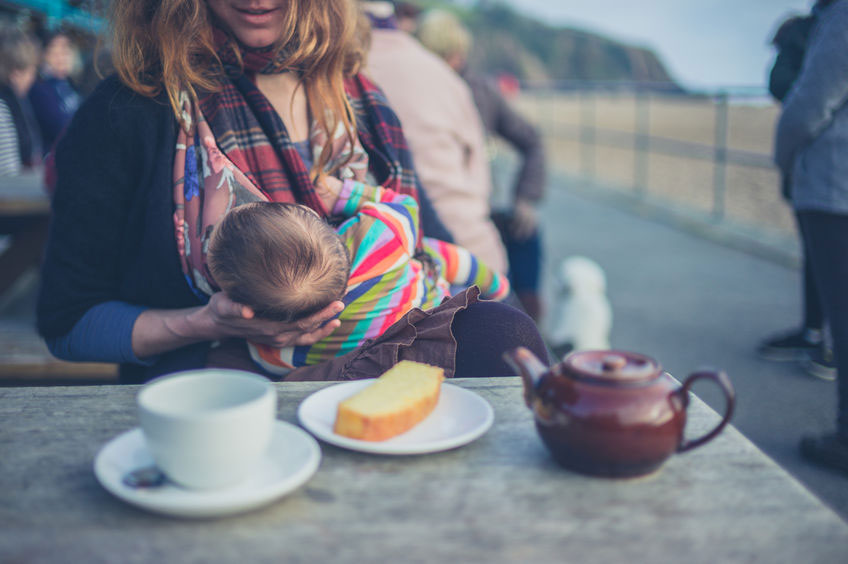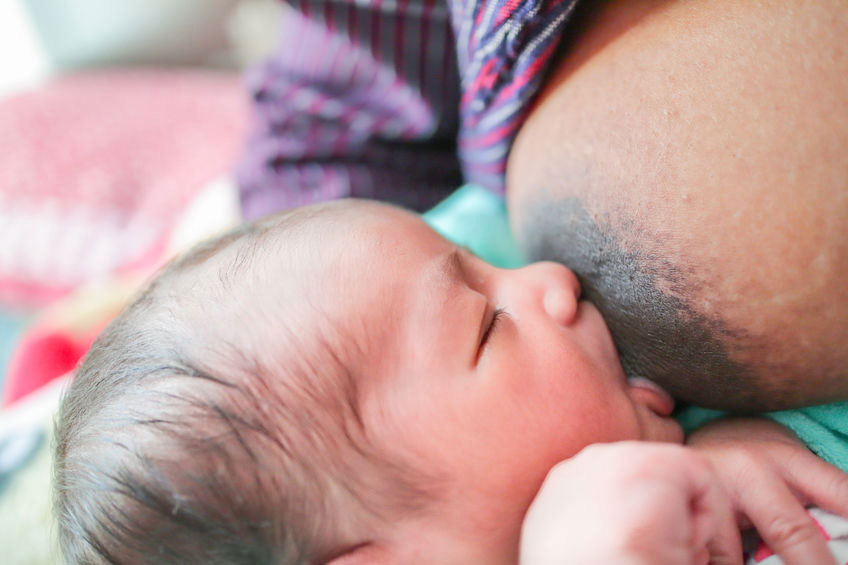Many mothers have breastfed successfully after previously having their nipples pierced. However, some mothers may encounter difficulties with blocked ducts, infections, reduced milk supply or leaking milk from the piercing site. This article looks at the risks and recommendations to be aware of when breastfeeding with pierced nipples and how nipple piercings might affect breastfeeding.

Precautions to note
Important precautions to be aware of when breastfeeding with pierced nipples include:
- Nipple piercings must be fully healed before breastfeeding starts
- Always remove nipple jewellery during breastfeeding
- Nipple piercings may be associated with problems breastfeeding
- Choosing reputable practitioners can minimise complications
Nipple piercings must be fully healed before breastfeeding starts
Nipple piercings take a long time to heal and breastfeeding is not recommended until healing is fully completed. Saliva should not enter the wound during the healing process as this could increase the risk of infection.
How long do nipple piercings take to heal?
Some authors report an average healing time for a nipple piercing as three to six months1 while others state healing may take six to twelve months. Bacterial infections, abscesses and other complications are possible during the healing process.23 In some cases full healing may take up to two years after a nipple piercing or even longer.4
Allow 12-24 months for healing
In view of the long healing time, it is usually recommended that a piercing is best done at least 12 to 18 months before becoming pregnant. This ensures that jewellery can remain in place for six to ten months after a piercing to allow for healing and the hole will be less likely to close when jewellery is removed for breastfeeding (Martin, 1999). Robyn Roche-Paull recommends getting a piercing done 18-24 months prior to pregnancy or three months after weaning from the breast.5 Most piercers will not pierce a pregnant or breastfeeding woman.
A piercing history can reveal pertinent information. If less than a year old, a piercing may not be fully healed. Nursing a baby on an unhealed piercing could be problematic. Some nipple piercings can take up to 18 months to heal completely. Close follow-up can ensure that any potential problems can be averted or minimized.
What about nipple piercings during pregnancy?
It is not recommended to have your nipples pierced during pregnancy due to the lengthy healing time needed. For existing piercings, Robyn Roche-Paull advocates removing jewellery before the sixth month of pregnancy to prevent the possibility of nipple stimulation or premature contractions. She also notes that hormonal changes and the increased nipple sensitivity of pregnancy could cause rejection or embedding of jewellery (Roche-Paull, 2014). Rejection is when the body rejects the foreign body (the jewellery) and the wound doesn’t heal properly, and embedding of jewellery involves skin growing over a piercing.
Always remove nipple jewellery during breastfeeding
Nipple jewellery should always be removed while you are breastfeeding as it poses a choking hazard for your baby (or older toddler) and could damage a baby’s gums, palate or tongue. Jewellery could also make it difficult for a baby to attach to the breast (latch) correctly, could make them gag and could increase the risk of infection for the baby. Constantly removing and replacing jewellery could increase the risk of bacterial infection or tenderness of the nipple. It is recommended to leave jewellery out for the duration of breastfeeding6 and most women find this easier.
Piercings may close during breastfeeding
Even allowing for 12-24 months healing time, some piercings may still close once jewellery is removed for breastfeeding. If the holes close, it is recommended to wait at least three months after breastfeeding ends before attempting piercing again should you wish to.7
Insertion tapers and retainers
To avoid the piercing healing over, some mothers use an insertion taper or temporary jewellery called a retainer to keep the holes open between feeds:
some mothers use a temporary piece of jewellery called a retainer. This smooth plastic tube can be removed and reinserted easily throughout the day, thereby facilitating breastfeeding and “retaining” or preventing the closure of a piercing.

Nipple piercings may be associated with problems breastfeeding
Many mothers with pierced nipples do not have any more breastfeeding issues than any other mother planning to breastfeed. With careful attention to latch and positioning and knowing how breastfeeding works, breastfeeding can get off to a good start. However, problems that have been associated with nipple piercings for some mothers include blocked ducts, mastitis, changes to milk flow, reduced milk supply, increased risk of bacterial infections, changes to nipple sensitivity and problems with continued milk production after weaning.
Blocked ducts or mastitis
In some cases piercings can cause damage to the little ducts that carry milk within the nipple. There are several nipple pores in a nipple so it is unlikely that they would all be damaged with a single piercing, however scarring inside the nipple could cause duct obstruction. If milk can’t flow from all areas of the breast this could lead to blocked ducts, mastitis, or abscess which could potentially reduce the milk supply in that breast.8 Multiple piercings in one nipple are more likely to increase scarring and be associated with difficulty breastfeeding (Martin, 1999).
Fast flow, slow flow
Milk may leak out of the sides of the nipple at the piercing site and milk flow could be affected causing a faster flow which some babies may struggle with. Sometimes milk may flow from the piercing site and not from the nipple pores at all. Alternatively if any of the ducts have been damaged, milk flow from that breast could be reduced causing slow flow which may be frustrating for some babies.
Reduced milk supply, low weight gain
Some mothers notice a reduced milk supply in the breast with a nipple piercing (Garbin et al, 2009) and this can be associated with low weight gain for the breastfed baby. Antenatal information to get breastfeeding off to a good start, and a postnatal breastfeeding assessment by an IBCLC lactation consultant will help to maximise your baby’s available milk. Regular weight checks will monitor whether your baby is getting enough milk. One sided breastfeeding from the other breast is possible if issues develop with one pierced nipple—the other breast can generally increase milk production to compensate.
Bacterial infection
There is an increased risk of bacterial infections and infective mastitis with pierced nipples so mothers will need to be vigilant for any signs of infection coming from the nipple (e.g. a discharge) or breast (redness, pain, engorgement). It is recommended that saliva should not enter a piercing wound as this could increase infection risk and is one of the reasons complete healing is preferred before breastfeeding starts. 9
Loss of sensitivity or increased sensitivity
Some mothers may lose sensitivity in their nipples following nipple piercing or others may have increased sensitivity. A lack of feeling could affect let-down of milk (milk ejection) and hypersensitivity could cause breastfeeding to be painful (Martin, 2004).
Continued milk production after weaning
Some mothers may find that their nipple piercings continue to stimulate milk production after weaning. Nipple piercings have also been associated with spontaneous milk production unrelated to breastfeeding.10
If any of the above difficulties do occur, a breastfeeding specialist such as an IBCLC lactation consultant can be a great support to help you.
Choosing reputable practitioners can minimise general complications
In addition to the breastfeeding related issues above, nipple piercings can carry risks of bacterial infection, scar tissue including keloid scars (raised scars), hepatitis, tetanus, transmission of HIV and hyperprolactinemia (high prolactin levels).11 There is also the possibility of rejection (the body rejects the jewellery and the wound doesn’t heal) and some women can develop allergies to the metal jewellery.
Minimise risk
To reduce the likelihood of infections and other complications, it is very important to choose reputable licensed practitioners, and follow all aftercare advice carefully. There is a summary of information and precautions on the UK’s National Health Service (NHS) article on Infected Piercings, 2023 and see Public Health England’s Body and Surface Piercing Aftercare sheet and their Tattooing and Body Piercing Guidance Toolkit, 2013.
Body piercers should take a complete medical and social history to identify conditions that may predispose an individual to complications, and candidates should choose a qualified practitioner to perform their piercing
Summary
In many cases breastfeeding will be unaffected by previously pierced nipples, in others a mother may have difficulty breastfeeding with pierced nipples due to blocked ducts, lowered milk supply or leaking milk. It is important that a nipple piercing has fully healed before breastfeeding, this could take up to two years in some cases. Jewellery should always be removed before breastfeeding as it may damage a baby’s mouth, cause difficulties with the attachment to the breast (latch), increase risk of infection and it is a choking hazard. An IBCLC lactation consultant can help to optimise breastfeeding success and solve any problems that might be unrelated to the piercing.
Always check with your health professional for advice if you have any medical concerns about your nipple piercings or your baby’s health or weight. This article should not be interpreted as medical advice.